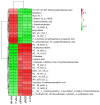An Analysis of the Intestinal Microbiome Combined with Metabolomics to Explore the Mechanism of How Jasmine Tea Improves Depression in CUMS-Treated Rats
- PMID: 39200564
- PMCID: PMC11353544
- DOI: 10.3390/foods13162636
An Analysis of the Intestinal Microbiome Combined with Metabolomics to Explore the Mechanism of How Jasmine Tea Improves Depression in CUMS-Treated Rats
Abstract
Recently, research has confirmed that jasmine tea may help improve the depressive symptoms that are associated with psychiatric disorders. Our team previously found that jasmine tea improved the depressive-like behavior that is induced by chronic unpredictable mild stress (CUMS) in Sprague Dawley (SD) rats. We hypothesized that the metabolic disorder component of depression may be related to the gut microbiota, which may be reflected in the metabolome in plasma. The influence of jasmine tea on gut microbiota composition and the association with depressive-related indexes were explored. Furthermore, the metabolites in plasma that are related to the gut microbiota were identified. SD rats were treated with control or CUMS and administrated jasmine tea for 8 weeks. The 16S rRNA gene amplicon sequencing was used to analyze the gut microbiota in feces samples, and untargeted metabolomics was used to analyze the metabolites in plasma. The results found that jasmine tea significantly ameliorated the depressive behavior induced by CUMS, significantly improved the neurotransmitter concentration (BDNF and 5-HT), and decreased the pro-inflammation levels (TNF-α and NF-κB). The intervention of jasmine tea also alleviated the dysbiosis caused by CUMS; increased the relative abundance of Bacteroides, Blautia, Clostridium, and Lactobacillus; and decreased Ruminococcus and Butyrivibrio in the CUMS-treated rats. Furthermore, the serum metabolites of the CUMS-treated rats were reversed after the jasmine tea intervention, i.e., 22 were up-regulated and 18 were down-regulated, which may have a close relationship with glycerophospholipid metabolism pathways, glycine serine and threonine metabolism pathways, and nicotinate and nicotinamide metabolism pathways. Finally, there were 30 genera of gut microbiota related to the depressive-related indexes, and 30 metabolites in the plasma had a strong predictive ability for depressive behavior. Potentially, our research implies that the intervention of jasmine tea can ameliorate the depression induced by CUMS via controlling the gut flora and the host's metabolism, which is an innovative approach for the prevention and management of depression.
Keywords: CUMS; gut microbiome; jasmine tea; metabolome.
Conflict of interest statement
The authors declare no competing financial interests.
Figures











Similar articles
-
Jasmine tea extract prevents CUMS-induced depression-like behaviors through the modulation of microbiota-gut-brain axis.Food Res Int. 2025 May;209:116214. doi: 10.1016/j.foodres.2025.116214. Epub 2025 Mar 14. Food Res Int. 2025. PMID: 40253129
-
Jasmine Tea Attenuates Chronic Unpredictable Mild Stress-Induced Depressive-like Behavior in Rats via the Gut-Brain Axis.Nutrients. 2021 Dec 27;14(1):99. doi: 10.3390/nu14010099. Nutrients. 2021. PMID: 35010973 Free PMC article.
-
Integrated 16S rRNA sequencing and metabolomics analysis to investigate the antidepressant role of Yang-Xin-Jie-Yu decoction on microbe-gut-metabolite in chronic unpredictable mild stress-induced depression rat model.Front Pharmacol. 2022 Sep 30;13:972351. doi: 10.3389/fphar.2022.972351. eCollection 2022. Front Pharmacol. 2022. PMID: 36249818 Free PMC article.
-
Impact of traditional Chinese medicine treatment on chronic unpredictable mild stress-induced depression-like behaviors: intestinal microbiota and gut microbiome function.Food Funct. 2019 Sep 1;10(9):5886-5897. doi: 10.1039/c9fo00399a. Epub 2019 Aug 29. Food Funct. 2019. PMID: 31464319
-
Investigating the antidepressant effect of Ziyan green tea on chronic unpredictable mild stress mice through fecal metabolomics.Front Microbiol. 2023 Aug 24;14:1256142. doi: 10.3389/fmicb.2023.1256142. eCollection 2023. Front Microbiol. 2023. PMID: 37692389 Free PMC article.
Cited by
-
Fu Brick Tea Protects the Intestinal Barrier and Ameliorates Colitis in Mice by Regulating Gut Microbiota.Foods. 2025 Mar 24;14(7):1122. doi: 10.3390/foods14071122. Foods. 2025. PMID: 40238292 Free PMC article.
-
Characterization of key aroma components of jasmine tea with diverse aroma types: Focus on jasmine tea scented with multipetal jasmine.Food Chem X. 2025 Jul 4;29:102734. doi: 10.1016/j.fochx.2025.102734. eCollection 2025 Jul. Food Chem X. 2025. PMID: 40686887 Free PMC article.
-
Relationship Between Depression and Epigallocatechin Gallate from the Perspective of Gut Microbiota: A Systematic Review.Nutrients. 2025 Jan 12;17(2):259. doi: 10.3390/nu17020259. Nutrients. 2025. PMID: 39861389 Free PMC article.
-
Modulating Gut Microbiota with Dietary Components: A Novel Strategy for Cancer-Depression Comorbidity Management.Nutrients. 2025 Apr 29;17(9):1505. doi: 10.3390/nu17091505. Nutrients. 2025. PMID: 40362814 Free PMC article. Review.
References
-
- Kelly J.R., Borre Y., O’Brien C., Patterson E., El Aidy S., Deane J., Kennedy P.J., Beers S., Scott K., Moloney G., et al. Transferring the blues: Depression-associated gut microbiota induces neurobehavioural changes in the rat. J. Psychiatr. Res. 2016;82:109–118. doi: 10.1016/j.jpsychires.2016.07.019. - DOI - PubMed
Grants and funding
- CARS-23/National Tea Industry Technology System Project
- 2020NK2026/Innovation and demonstration of key technologies for jasmine tea scenting processing
- 2024JJ7497/The effects and mechanisms of EGCG on reproductive viability in CUMS rats
- Xiangjiaotong [2023] No. 233/Science and Technology Innovation Team support project of Hunan Normal High School
LinkOut - more resources
Full Text Sources

